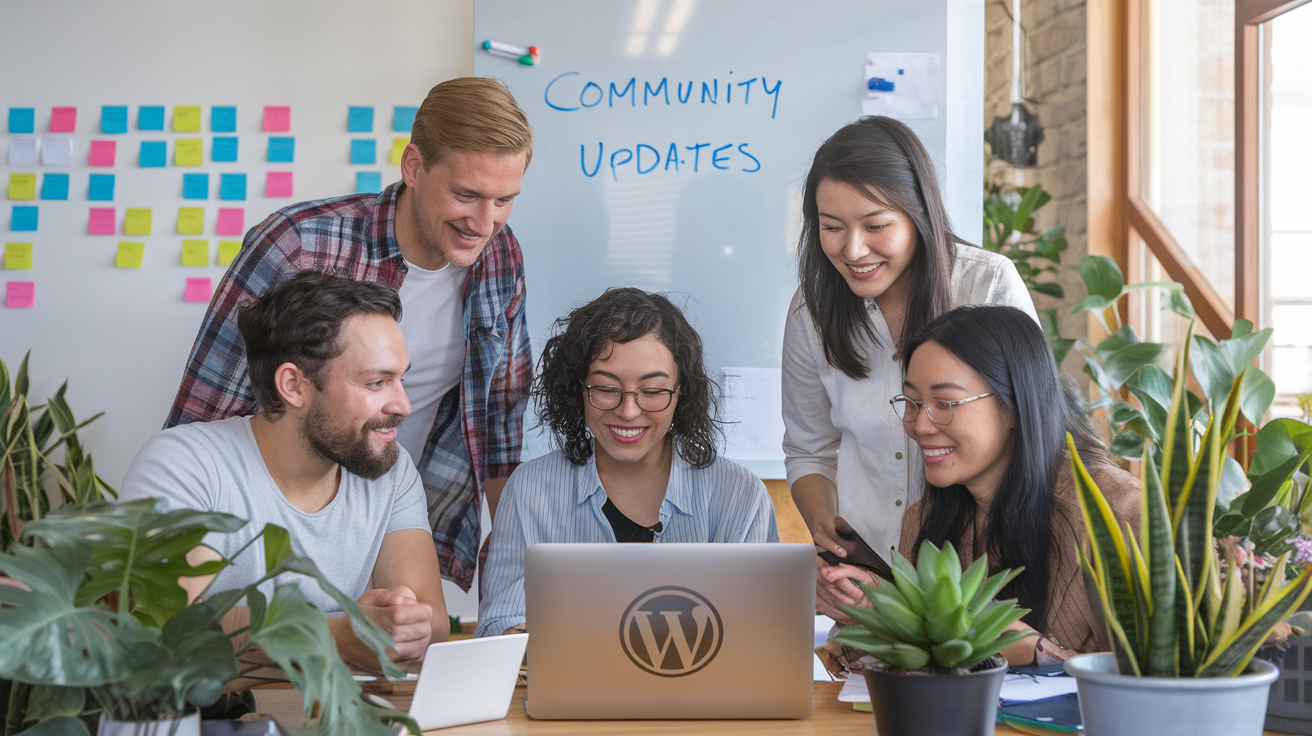
Are you ready to dive into the ever-evolving world of WordPress? 🚀 The blogosphere is buzzing with excitement as WordPress 6.8 Release Candidate 1 is released, bringing a wave of changes that could reshape the way we create and manage content online. From major shifts in the development cycle to exciting new tools and features, the WordPress landscape is transforming before our eyes.
But that’s not all – the WordPress community is facing unprecedented challenges and opportunities. With Automattic’s recent layoffs and reduced contributions to WordPress.org, questions about the project’s future are on everyone’s mind. Yet, amidst the uncertainty, innovation thrives. New AI-powered website builders, enhanced privacy tools, and groundbreaking plugins are emerging to empower users like never before.
In this post, we’ll explore the latest trends, updates, and industry news that are shaping the WordPress ecosystem. From community updates and WordPress.com enhancements to valuable learning resources and legal developments, we’ve got you covered. So, whether you’re a seasoned developer or a curious beginner, buckle up – it’s time to uncover what’s trending in the blogosphere and how it might impact your WordPress journey. 🌟
WordPress 6.8: The Latest Release

Release timeline and beta versions
WordPress 6.8, the latest release in the WordPress ecosystem, is generating significant buzz among developers. While the exact release timeline is not specified in the reference content, it’s clear that this version is currently in its beta phase, with developers and early adopters actively testing and providing feedback on the new features and improvements.
The beta versions of WordPress 6.8 are crucial for identifying and resolving potential issues before the official release. During this phase, the WordPress community is encouraged to test the new features, report bugs, and contribute to refining the overall user experience.
Key features and improvements
WordPress 6.8 introduces a range of exciting features and improvements designed to enhance performance, user experience, accessibility, and security. One of the standout features is the integration of speculative loading, which preloads expected resources to expedite page transitions. This feature utilizes the Performance Team’s existing plugin, allowing developers to customize preloading behavior. This results in faster navigation and an improved user experience, particularly for content-heavy sites.
The Style Book, a popular design management tool, is receiving significant improvements in this release. It will now activate sections as users navigate, making the Site Editor experience simpler. Additionally, the Style Book feature has been extended to classic themes that support the Full Site Editor, allowing users to visualize and manage styles more efficiently without needing to switch to block themes.
Security measures have also been bolstered in WordPress 6.8. The update introduces default warnings for risky settings that could lead to unauthorized access, enhancing overall site security. Moreover, there is a significant upgrade to password hashing algorithms, with the implementation of bcrypt replacing the outdated MD5 algorithm. This change strengthens password security without requiring user intervention.
Other notable improvements include:
- A new Block Inserter panel for streamlined handling of starter content
- A standardized tooltip system to enhance accessibility
- Updates to WP_Query cache key generation for optimized database performance
- Border customization options for bundled themes
- The introduction of a Query Total block for displaying the number of posts in query loops
- The option to ignore sticky posts in custom layouts
Community response and adoption
The WordPress community has shown considerable interest in the features and improvements introduced in version 6.8. The focus on performance enhancements, particularly the speculative loading feature, has been well-received by developers and site owners looking to optimize their websites.
The improvements to the Style Book and the extension of this feature to classic themes have garnered positive feedback from designers and content creators. These updates are seen as steps towards a more intuitive and flexible design management experience within WordPress.
The community has also appreciated the emphasis on accessibility, with the standardized tooltip system and improved administrative notices being highlighted as essential steps towards creating a more inclusive web experience.
However, as with any major update, users are encouraged to exercise caution when upgrading. It’s recommended to assess compatibility, particularly for sites using legacy plugins or outdated code. Proper site backups and testing in a staging environment are advised before implementing the update on live sites.
With these significant enhancements and the positive community response, WordPress 6.8 is poised for widespread adoption once it moves out of the beta phase and is officially released.
Now that we’ve covered the latest release of WordPress 6.8, let’s turn our attention to the major changes in the WordPress development cycle. This will provide insight into how these updates are planned and implemented.
Major Changes in WordPress Development Cycle

Now that we’ve explored the latest features in WordPress 6.8, let’s take a look at the significant changes happening in the WordPress development cycle. These changes are set to reshape the future of this popular content management system.
A. Shift to single major release in 2025
In a groundbreaking announcement, Mary Hubbard revealed a substantial shift in the WordPress release schedule. Starting from 2025, WordPress will transition from its current three major releases per year to a single annual major release. This decision comes as a response to ongoing legal challenges that have impacted the organization’s resources and energy.
The final major release under the current schedule will be WordPress 6.8, codenamed “Cecil.” This adjustment allows the WordPress team to focus on critical tasks, such as reducing technical debt, improving performance, and supporting community plugins. It’s worth noting that this change doesn’t mean a complete halt in updates. Minor releases will continue as necessary, focusing on maintenance and security improvements.
To maintain transparency and collaboration within the community, WordPress will introduce quarterly town halls for core committers. These sessions will provide a platform for developers to discuss progress, share insights, and coordinate efforts more effectively.
Looking ahead, this new release cadence positions WordPress 7.0 for a 2027 release. This version is anticipated to be a significant milestone, reflecting both the platform’s evolution and its future aspirations.
B. Impact of Automattic’s layoffs on contributions
While the reference content doesn’t directly mention Automattic’s layoffs, it’s essential to consider the context of the development cycle changes. The shift to a single annual release and the focus on essential tasks suggest that resources may be more constrained. This could potentially be linked to broader changes within the WordPress ecosystem, including any staffing adjustments at Automattic, the company closely associated with WordPress development.
The emphasis on reducing technical debt and enhancing performance indicates a strategic realignment of priorities. This approach may help mitigate the impact of any resource constraints while ensuring the continued improvement and stability of the WordPress platform.
C. Concerns about the future of the open-source project
The changes in the WordPress development cycle have naturally raised concerns about the project’s future. However, it’s crucial to note that the WordPress team has addressed these concerns proactively.
The announcement emphasizes that the shift to an annual release cycle is a temporary measure. Should the legal issues affecting the organization be resolved, there is a possibility of reverting to the previous three releases per year cadence. This flexibility demonstrates the team’s commitment to adapting to challenges while maintaining the community-driven nature of WordPress.
Furthermore, the introduction of quarterly town halls for core committers is a clear indication of WordPress’s dedication to preserving its open-source spirit. These sessions will foster collaboration, ensure transparency, and keep the community engaged in the development process.
The focus on supporting community plugins also underscores the continued importance of the open-source ecosystem. By allocating more resources to these areas, WordPress aims to strengthen its relationship with developers and maintain the vibrant community that has been crucial to its success.
As we transition to discussing the exciting new tools and features in WordPress, it’s clear that despite the changes in the development cycle, the platform continues to evolve. The shift to a more focused release schedule may even lead to more robust and well-tested features in future updates. With this in mind, let’s explore the innovative tools and enhancements that are shaping the WordPress experience for both users and developers.
Exciting New Tools and Features

Now that we’ve explored the significant changes in the WordPress development cycle, let’s dive into some exciting new tools and features that are transforming the WordPress landscape.
AI Website Builder on WordPress.com
WordPress.com has introduced a groundbreaking AI website builder, designed to cater to a wide range of users, including entrepreneurs, small business owners, freelancers, bloggers, and developers. This innovative tool aims to simplify creating a professional online presence without requiring extensive technical skills.
The AI website builder enables users to create visually appealing and functional websites in minutes. Here’s how it works:
- Users provide details about their website idea.
- The AI constructs the site based on the provided information.
- Users can make manual adjustments or updates through a chat interface.
One of the key advantages of this tool is its ability to quickly generate a complete website. However, it’s worth noting that the current version is not well-suited for e-commerce or complex integrations.
To maximize the potential of the AI builder, users are encouraged to provide detailed prompts that specify their site’s purpose and content. The tool offers 30 free prompts for new WordPress.com sites, allowing users to customize their sites further and return to the tool whenever inspiration strikes.
For those who prefer traditional site-building methods, WordPress retains its standard editing tools. Users on higher plans can manually edit and enhance their sites, providing flexibility for both novices and experienced developers.
WPConsent for Privacy Compliance
While the reference content doesn’t specifically mention WPConsent, it’s worth noting that privacy compliance is an essential aspect of website development. As WordPress continues to evolve, tools and features that help users maintain privacy standards are likely to be in high demand.
Enhanced Plugin Functionalities
The reference content doesn’t provide specific information about enhanced plugin functionalities. However, it’s important to note that WordPress continually improves its ecosystem, which includes regular updates and enhancements to plugin capabilities.
Pricing and Availability
To fully utilize the AI website builder and host their sites, users need to purchase a WordPress hosting plan. The options include:
- Premium plan: $18 per month (or $8 per month if billed annually)
- Business plan: $40 per month (or $25 per month when billed annually)
Both plans include a free domain for the first year, adding value to the package.
User Experience and Customization
While the AI facilitates the building process, users may find that further personalization requires additional time and effort. The experience with the AI builder is generally positive, with many users finding the Premium plan reasonably priced.
The AI provides step-by-step assistance for layout, colors, and fonts, making it easier for users to create a site that aligns with their vision. This feature is beneficial for those who have long-planned sites but haven’t had the technical expertise to launch them.
As we look ahead to the WordPress Community Updates, it’s clear that these new tools and features are sparking conversations and driving innovation within the WordPress ecosystem. The introduction of AI-powered website building tools represents a significant step towards simplifying web development, while still offering the flexibility and control that WordPress users have come to expect.
WordPress Community Updates

Now that we’ve explored the exciting new tools and features in WordPress, let’s turn our attention to the vibrant WordPress community and its recent updates.
WordCamp Asia 2025 highlights
WordCamp Asia 2025 is set to be a landmark event in the WordPress calendar, taking place from February 20th to 22nd at the Philippine International Convention Center (PICC) in Manila. This community-driven conference promises to be a melting pot of knowledge sharing, networking, and exploration of cutting-edge WordPress technologies.
Attendees can look forward to:
- Engaging sessions on various WordPress topics
- Networking opportunities with fellow enthusiasts and industry leaders
- Discovering new business prospects within the WordPress ecosystem
- Experiencing the rich local culture and renowned hospitality of the Philippines
The event will feature innovative programs designed to enhance attendee engagement:
- Solutions Spotlight: Rapid-fire 10-minute talks showcasing cutting-edge products and strategies
- YouthCamp: Hands-on workshops for children and teens aged 8-17, focusing on web design and development fundamentals
- Career and Social Corners: Dedicated spaces for job exploration and informal discussions
Profiles of notable WordPress contributors
WordCamp Asia has become a platform for recognizing and celebrating the contributions of notable WordPress community members. While specific names aren’t mentioned in the reference content, the event highlights the collaborative spirit of the WordPress ecosystem:
- Nearly 800 contributors participated in the recent Contributor Day
- Participants made significant contributions, including bug fixes and performance enhancements
- The growth of the WordPress community since its inception in 2008 was emphasized in the opening remarks
Key figures in the WordPress community who have made significant impacts include:
- Matías Ventura: Delivered an inspiring keynote on the future of Gutenberg
- Matt Mullenweg, WordPress co-founder, participated in a live Q&A session addressing topics such as AI and education within the WordPress sphere
Changes in community leadership and engagement
The WordPress community continues to evolve, with several changes in leadership and engagement strategies:
- Increased focus on diverse participation:
- Introduction of YouthCamp to engage younger individuals in WordPress
- Career Corner facilitates job exploration within the WordPress ecosystem
- Enhanced collaborative efforts:
- Contributor Day attracted a large number of participants, including 126 newcomers
- 19 Make WordPress teams work on various projects during the event
- Emphasis on technical advancements:
- Sessions addressing integration with external applications
- Workshops catering to diverse skill levels
- Discussions on AI-driven workflows and their impact on user experiences
- Community-driven decision making:
- Panel discussions on the future of WordPress, emphasizing the role of the community in shaping its evolution
- Q&A sessions with leadership figures like Matt Mullenweg
- Global expansion:
- Upcoming WordCamp events in Europe and the US
- WordCamp Asia 2026 planned for Mumbai, potentially becoming the largest flagship event yet
These community updates reflect the dynamic nature of the WordPress ecosystem, with a strong emphasis on collaboration, innovation, and inclusivity. As we move forward, the WordPress community continues to play a crucial role in shaping the platform’s future and driving its growth.
With these community updates in mind, let’s now turn our attention to the recent enhancements made to WordPress.com, which further demonstrate the platform’s commitment to user experience and functionality.
WordPress.com Enhancements

Now that we’ve explored the latest WordPress community updates, let’s delve into the recent enhancements made to WordPress.com, which have significantly impacted the user experience and functionality of the platform.
Updated user interface
WordPress.com has undergone a significant transformation in its user interface, aligning it more closely with the core WordPress experience. This change involves phasing out the custom “Calypso” interface, a distinctive feature of WordPress.com for years. The transition aims to create a more unified and familiar environment for users across all WordPress products.
Several factors drive the shift from Calypso to the standard wp-admin interface:
- Unified experience: By adopting the standard WordPress interface, users can enjoy a consistent experience across different WordPress environments.
- Improved support: The change allows for better utilization of existing documentation and resources, making it easier for users to find help and tutorials.
- Resource optimization: Maintaining two separate interfaces had become complex and resource-intensive. This move frees up resources for innovation and other improvements.
However, the transition has been met with mixed reactions from the WordPress.com community. Many long-time bloggers have expressed dissatisfaction with the changes, citing issues such as:
- Increased clutter in the new interface
- Difficulty in navigation
- Loss of features they found essential in Calypso, such as the ability to view post statistics and likes in one place.
Some users have reported challenges in tracking statistics, issues with post title reversion when copying, and the removal of convenient scheduling features for social media sharing. Despite these criticisms, some users have adapted to the new interface and noted improvements in certain functionalities.
100-year domains and plans
While the reference content doesn’t explicitly mention 100-year domains and plans, it’s worth noting that WordPress.com continues to innovate in its offerings to users. The platform’s focus on long-term sustainability and user commitment is evident in its ongoing efforts to enhance and expand its services.
Versatility for various website types
WordPress.com’s recent updates have solidified its position as a versatile platform that supports a wide range of website types. The alignment with the core WordPress experience opens up new possibilities for users, allowing them to leverage a broader range of features and functionalities.
The platform’s enhancements are designed to cater to a range of user needs, from simple blogs to complex websites. This versatility is reflected in the ongoing efforts to improve the user interface and introduce new features that can benefit various website types.
As we transition to the next section on Learning Resources and Support, it’s clear that these WordPress.com enhancements have created both opportunities and challenges for users. The platform’s commitment to innovation and user experience is evident, but it also highlights the importance of providing adequate resources and support to help users navigate these changes effectively.
Learning Resources and Support

Now that we’ve explored the exciting enhancements to WordPress.com, let’s shift our focus to the wealth of learning resources and support available for WordPress users of all levels.
WPBeginner’s comprehensive tutorials
WPBeginner offers an extensive collection of tutorials tailored for WordPress enthusiasts. Their resources cover a wide range of topics, from basic site management to advanced customization techniques. For those just starting, WPBeginner recommends dedicating a few hours each day for a week to grasp the fundamentals of WordPress.
Their structured five-day learning plan is beneficial for beginners:
- Day 1: Choose between WordPress.org (self-hosted) and WordPress.com, with a focus on selecting a domain name and web hosting.
- Day 2: Familiarize yourself with the WordPress dashboard and essential concepts.
- Day 3: Explore the power of plugins to enhance website functionality.
- Day 4: Learn how to select and install themes for your site.
- Day 5: Dive into customization techniques to make your WordPress site unique.
Redesigned “Learn WordPress” educational hub
The redesigned “Learn WordPress” hub offers a comprehensive curriculum for users at various skill levels. This educational platform features Learning Pathways that cater to beginners, intermediate users, and advanced WordPress enthusiasts.
Key courses include:
- Beginner WordPress User: 4 hours and 24 lessons covering essential site creation and content management skills.
- Beginner WordPress Developer: 9 hours and 59 lessons focused on WordPress functionality and extensions.
- Intermediate WordPress User: 7 hours and 37 lessons on advanced features and content strategies.
- Intermediate Theme Developer: 8 hours and 32 lessons teaching custom block theme development for WordPress.org.
- Advanced WordPress User: 3 hours and 20 lessons enhancing skills in custom functionalities and site optimization.
The hub also offers specialized courses, such as “Creating a 4-Page Business Website” and “Using the WordPress Data Layer,” for practical skill development.
Expert guidance for WordPress beginners
For those new to WordPress, expert guidance is readily available through various channels:
- WordPress.com courses: Beginner-friendly options include:
- Creating a website course: Guides users through the essential steps of building a website.
- Newsletters 101: Teaches crafting engaging newsletters and exploring monetization options.
- Intro to SEO: Focuses on enhancing site visibility through practical keyword usage and content optimization.
- Featured lessons include diverse formats, such as videos and practical exercises, that address specific topics like landing page creation and website optimization.
- Online workshops: Live interactions with WordPress professionals provide invaluable insights and personalized learning experiences.
- Community support: The WordPress community offers extensive resources and support through forums, social media platforms (such as Facebook, Twitter, Instagram, and YouTube), and the opportunity to join the Training team for those passionate about sharing their WordPress knowledge.
As we conclude our exploration of learning resources and support, it’s clear that WordPress users have a wealth of options to enhance their skills and knowledge. With these tools at your disposal, you’ll be well-equipped to navigate the ever-evolving WordPress landscape. In our next section, we’ll explore industry news and legal developments, keeping you up to date on the latest trends and regulations affecting the WordPress ecosystem.
Industry News and Legal Developments

Now that we’ve explored the various learning resources and support available to WordPress users, let’s delve into some of the latest industry news and legal developments shaping the WordPress ecosystem.
A. WP Engine’s injunction against Automattic
In a significant legal battle that has captured the attention of the WordPress community, WP Engine has filed a lawsuit against Automattic, the company behind WordPress.com. This dispute, which began in September 2024, centers around trademark issues and has far-reaching implications for the WordPress ecosystem.
The conflict began when WP Engine received a cease-and-desist letter from Automattic regarding its use of the WordPress trademark. WP Engine argued that their usage fell under fair use, but the situation quickly escalated. In response, Matt Mullenweg, the co-founder of WordPress and CEO of Automattic, took the drastic step of banning WP Engine from accessing WordPress.org resources. This action caused significant disruption to many websites that relied on these services.
The community’s reaction to this ban was largely adverse, with WP Engine claiming that it not only hindered their operations but also affected all users depending on their tools. In an attempt to de-escalate the situation, WP Engine temporarily lifted the ban and made efforts to clarify its non-affiliation with the WordPress Foundation. They also revised their service names to avoid trademark conflicts.
Despite these changes, Mullenweg maintained that WP Engine’s continued resistance to a licensing agreement was problematic. This stance has raised concerns within the community about Automattic’s control over the WordPress trademark and the potential for similar actions against other companies in the future.
B. Ongoing discussions about the Gutenberg block editor
While the legal battle between WP Engine and Automattic has dominated recent headlines, discussions about the Gutenberg block editor remain a hot topic in the WordPress community. However, the reference content doesn’t provide specific information about these ongoing discussions, so we’ll move on to the following subheading.
C. Impact of recent exits from the WordPress ecosystem
The WordPress ecosystem has recently experienced some significant shifts, notably with the departure of 159 employees from Automattic. This exodus has highlighted internal dissent regarding Mullenweg’s management style and the company’s overall direction.
These departures have sparked discussions about corporate governance within the WordPress ecosystem and raised questions about the platform’s future direction. Many stakeholders are calling for increased transparency and more equitable governance in response to concerns about perceived monopolistic control.
The legal challenges, community reactions, and corporate governance issues collectively suggest that WordPress is at a pivotal moment. The community is closely watching how these developments will shape the platform’s future and its ecosystem.
As we move forward, it’s clear that staying informed and connected with the latest developments in the WordPress community is more crucial than ever. In the next section, we’ll explore ways to keep up-to-date with these rapidly evolving situations and maintain your connection to the WordPress community.
Stay Informed and Connected

Now that we’ve explored the industry news and legal developments affecting WordPress, let’s shift our focus to how you can stay informed and connected with the latest happenings in the WordPress ecosystem.
WordPress.com newsletter subscription
Staying up to date with WordPress.com’s latest features and updates is crucial for maximizing your blogging experience. One of the most effective ways to do this is by subscribing to the WordPress.com newsletter. This powerful tool not only keeps you informed but also offers valuable insights for engaging your audience and potentially monetizing your content.
The WordPress.com newsletter offers users a customizable platform to create and manage their subscriber lists without requiring any coding skills. You can easily set up your newsletter with unlimited sends and subscribers, allowing you to reach your audience effectively. For those looking to generate income from their content, the newsletter feature supports monetization through subscriptions and gated content.
If you’re migrating from another platform, such as Substack, WordPress.com makes it simple to import your existing newsletter and subscribers. This seamless transition ensures you don’t lose your hard-earned audience when making the switch.
Social media channels for updates
In addition to the newsletter, WordPress.com maintains an active presence on various social media platforms. These channels serve as excellent resources for real-time updates, tips, and community engagement. By following WordPress.com’s social media accounts, you can:
- Receive instant notifications about new features and updates
- Participate in discussions with other WordPress users and developers
- Get quick access to support resources and troubleshooting guides
- Discover inspiring success stories from fellow bloggers
Make sure to follow WordPress.com on platforms like Twitter, Facebook, and Instagram to stay connected with the broader WordPress community and never miss important announcements.
Tracking Black Friday deals for premium tools.
For those looking to enhance their WordPress experience with premium tools and services, keeping an eye on Black Friday deals can lead to significant savings. While the reference content doesn’t specifically mention Black Friday deals, it’s worth noting that WordPress.com and many third-party developers often offer special promotions during this time.
To stay informed about these deals:
- Keep a close watch on WordPress.com’s official channels as Black Friday approaches
- Subscribe to newsletters of popular WordPress plugin and theme developers
- Join WordPress-focused forums and communities where users often share deal information
By leveraging these strategies, you can stay up-to-date with the latest WordPress news, updates, and opportunities to enhance your blogging toolkit. Remember, staying informed and connected is key to making the most of your WordPress experience and effectively growing your online presence.

The WordPress ecosystem continues to evolve rapidly, with significant changes in development cycles, exciting new features, and important community updates. From the latest WordPress 6.8 release to significant shifts in Automattic’s contribution strategy, the landscape is transforming. New tools, such as AI website builders and innovative plugins, are enhancing user experiences, while legal developments and industry news shape the platform’s future.
As we navigate these changes, staying informed and connected is more crucial than ever. Whether you’re a beginner exploring Learn WordPress or a seasoned developer contributing to the open-source project, the WordPress community offers numerous resources and support. By engaging with the latest trends, participating in events like WordCamp, and leveraging the wealth of tutorials and guides available, you can make the most of WordPress’s robust ecosystem and continue to grow your online presence.


